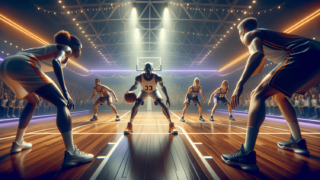
Are you an aspiring baller looking for ways to level up your game within the confines of your own home? You’ve come to the right place! This comprehensive guide titled, “How to Improve Your Basketball Skills at Home?” is jam-packed with accessible tips, tricks, and techniques to help transform you into the unstoppable player you’re meant to be. Combining fun with professionalism, we will shed light on some of the most effective drills and approaches, allowing you to harness your passion for basketball and gain that competitive edge. Say goodbye to idle days at home and get ready to elevate your game – let’s dribble our way to greatness, shall we?
How to Improve Your Basketball Skills at Home?
To improve your basketball skills at home, focus on strengthening key areas such as ball handling, shooting, and physical conditioning. Dedicate time to drills that perfect your dribbling, passing, and shooting fundamentals. Improve your footwork, balance, and agility through targeted exercises like jump ropes or ladder drills. Enhance your physical conditioning by incorporating cardiovascular and strength training workouts into your routine. Additionally, take advantage of online resources or basketball apps to help refine your understanding of the game, study plays, and analyze techniques employed by professional players.
Master the Art of Ball Handling
Exceptional ball handling is a cornerstone of basketball success. By refining your dribbling and passing skills, you’ll be on your way to becoming an indispensable player on any team. Here are some practical exercises that you can do at home:
Two-Ball Dribbling
As the name suggests, this exercise requires you to simultaneously dribble two balls, fostering improved ball control and enhancing ambidextrous coordination. Start with a basic bounce, moving up to figure eights, crossovers, and alternating-height dribbles as you become more adept.
Wall Passing
Find a solid wall in your house, preferably outdoors, and practice passing the ball against it with both one and two hands. Focus on accuracy and consistency with a strong, forceful pass. Determine a target spot on the wall, and aim to hit it time and time again.
Hone Your Shooting Techniques
When it comes to making baskets, practice really does make perfect. Although it certainly helps to have a hoop at home, there are still ways to improve your shooting technique sans net.
Form Shooting
This exercise is designed to perfect your shot release, follow-through, and alignment. To begin, stand 3-5 feet from the hoop, feet shoulder-width apart, and knees slightly bent. Assume the proper shooting position, with your shooting hand under the ball and your guide hand on the side of it. Set your eyes on the target, and release, following through with your shooting arm. Aim to maintain a consistent, fluid motion.
B.E.E.F. Principle
Remembering the B.E.E.F. acronym can help instill proper shooting techniques. It stands for Balance, Eyes, Elbow, and Follow Through. Add this to your training repertoire, and watch as your shooting mechanics become more polished.
Strengthen Your Physical Conditioning
Physical conditioning is a crucial aspect of enhancing your basketball skills. Improving your strength, endurance, and agility will help you perform at your absolute best on the court. Here’s how to do so from the comfort of your own home:
Cardiovascular Training
Cardio exercises like running, jumping jacks, and burpees are excellent ways to improve your stamina and overall fitness. Aim for at least 20-30 minutes per session, 3-5 times a week. High-intensity interval training (HIIT) can also be a game-changer, especially when tailored to replicate the intensity of an actual basketball game.
Strength Training
Bodyweight exercises such as push-ups, squats, and lunges are effective ways to build muscle and improve your on-court performance. For a more specialized approach, research specific exercises that target the muscle groups utilized in basketball — your legs, arms, and core.
Enhance Your Footwork and Agility
Refined footwork and agility facilitate smoother gameplay, allowing you to outmaneuver your opponents and secure the competitive edge. Here are some drills to elevate your footwork game:
Jump Rope
Jumping rope is a simple yet highly effective way to enhance your coordination, foot speed, and jumping ability. Alternating between single-leg and double-leg skips, high knees, or other variations will help you get the most out of this exercise.
Ladder Drills
Agility ladder drills, like the Ickey Shuffle or the Two-In, Two-Out, are perfect for improving footwork and coordination. They also help develop the muscle memory required for swift on-court movement. While an actual agility ladder is ideal, you can easily replicate one at home. Trace a makeshift ladder using chalk on a driveway, or simply use your imagination!
Expand Your Basketball IQ
Boost your understanding of the game by analyzing professional players and their strategies. From breaking down plays, to studying offensive and defensive techniques, these resources can prove invaluable:
Watch Recorded Games
Observe and dissect professional basketball games to identify various underlying strategies. Take notes on player positioning, ball movement, and defensive plays, aiming to actively engage with the game rather than passively watch. Analyze how the pros react to different situations, then set about integrating these skills into your own gameplay.
Attend Online Basketball Camps and Seminars
Many coaches and athletes offer virtual programs where they share insights about their journeys, training methods, and game strategies. Join an online basketball camp or seminar to immerse yourself in the sport, interact with other aspiring players, and learn from the best.
Make Use of Basketball Apps and Online Tools
There are countless basketball-specific apps and online tools designed to deepen your understanding of the game. Ranging from interactive playbooks to workout trackers, these resources are at your disposal.
Visualize Success
Visualization can be an incredibly powerful tool in developing your basketball prowess. When you mentally picture yourself executing a perfect layup or nailing a 3-pointer, you train your mind and body simultaneously. The resulting confidence and resilience can translate to tangible improvements on the court.
Mental Rehearsal
Throughout your training journey, set aside time for mental rehearsal, whether it be before bed or during a break between drills. Close your eyes and vividly imagine yourself outwitting opponents and overcoming challenges in various game scenarios. Remember, the more detailed your mental imagery, the more effective your visualizations will be.
Set Achievable Goals
Establish clear, measurable goals to drive your progress and motivation. These objectives can range from increasing your vertical jump to improving your free throw percentage. By setting and working toward these benchmarks, you can effectively propel yourself toward basketball greatness.
Stay Consistent and Persistent
Ultimately, the key to improving your basketball skills at home lies in relentless dedication and unwavering discipline. Consistently make time for your training, and you’ll see results sooner rather than later:
Create a Schedule
A well-structured training schedule not only keeps you focused and accountable, but helps you effectively allocate time to different aspects of your game (e.g., shooting, dribbling, and strength training). Feel free to experiment with different routines to find the most effective method for you.
Put in the Work
Perseverance is crucial when it comes to refining your basketball abilities. There will be some days when your progress feels sluggish, but it’s essential to remember that setbacks are an inevitable part of the journey. Keep pushing forward, and allow the process to unfold over time.
Bolster Your Defensive Capabilities
Defense is vitally important in basketball, and there are many effective ways to improve your skills even while at home. Enhancing your defensive stance, quickness, and anticipation can help you emerge as a linchpin player on your team. Let’s look at some initiatives you can adopt:
Defensive Stance Drills
Start by perfecting your defensive stance, which involves keeping your feet shoulder-width apart, bending your knees, and maintaining a low center of gravity. Exercises such as lateral slides or drop steps can improve your ability to maintain an ideal stance throughout games.
Defensive Reaction Drills
Various drills can help sharpen your defensive reflexes, such as tennis ball catches and mirror drills. Practicing these exercises will improve your hand-eye coordination and response time, ultimately benefiting your on-court defense.
Practice Rebounding Techniques
Rebounding is an essential skill in basketball that can be practiced in the comfort of your home. Great rebounders anticipate the trajectory of the ball and position themselves strategically. Use these drills to refine this aspect of your game:
Jumping Drills
Jumping drills, such as squat jumps or box jumps, can help develop explosion and power in your legs. These exercises not only improve your vertical leap but also enable better offensive and defensive rebounding. Aim to train consistently, gradually increasing intensity.
Box Out Drills
Boxing out is critical for securing rebounds, ensuring you deny your opponent the opportunity to grab the ball. Practice this skill by engaging a family member or friend – have them simulate an attempted rebound while you block them out, using your body to “box them out.”
Improve Your Court Vision and Decision-Making
Great basketball players possess not only physical prowess but also an excellent understanding of the game. By developing your court vision and decision-making skills, you will become a smarter player and a more valuable asset to your team:
Analyze Game Film
Dedicate time to watching game film, whether it’s of professionals, fellow players, or even yourself. Focus on identifying strategic decision-making and awareness; then, apply these insights to your own gameplay through visualization and practice.
Become a Student of the Game
Read books, articles, or insightful interviews to educate yourself on the nuances of basketball strategies, tactics, and philosophies. Familiarize yourself with concepts such as ‘hero ball’ or the ‘Princeton offense‘ and consider how they might relate to your own play style.
Keep in mind, greatness is achieved through determination, consistency, and adaptability. As you amass knowledge and refine your technique, remember to approach both your training and the game of basketball itself with unwavering confidence and enthusiasm. Soon enough, you’ll find yourself dominating the court and making a meaningful impact on your team.
FAQ on Improving Basketball Skills at Home
In this comprehensive FAQ section, we’ll address some common questions that people have about advancing their basketball skills at home. From honing specific abilities to practicing without specialized equipment, find the tips you need to become the best basketball player you can be:
1. Can I really improve my basketball skills without access to a court?
Yes, you can definitely improve your basketball skills without access to a court. While certain aspects of your game – like shooting on an actual hoop – may be limited, there are plenty of drills and exercises designed to refine your ball handling, footwork, and overall physical conditioning. By staying consistent in your training, you’ll see significant improvements on the court when you do have access.
2. How often should I practice to see the best results?
To see the best results, aim to practice at least 4-6 times a week for a minimum of 45-60 minutes per session. A consistent routine fosters steady progress and helps ingrain skills into your muscle memory. Additionally, ensure you are prioritizing rest and recovery to avoid overtraining or injuries.
3. What if I don’t have any basketball equipment at home? How can I practice effectively?
While having a basketball and a hoop is ideal, there are various exercises you can implement even without these items. You can practice dribbling and passing techniques by using a ball of a similar size and weight, such as a soccer ball. Alternatively, you can focus on physical conditioning and agility drills like running, squat jumps, and ladder drills to improve your overall athletic performance.
4. How important is mental training in basketball?
Mental training is crucial to basketball success, as it enhances focus, motivation, and resilience. Techniques like visualization and setting achievable goals assist in this area, allowing players to develop the mental fortitude necessary to thrive under pressure and stay motivated through obstacles.
5. Can watching professional basketball help me improve?
Watching professional basketball can absolutely help you improve, especially when combined with active analysis and reflection. Observe games through a strategic lens, identifying patterns and techniques employed by successful players; be sure to take notes, as many details can be incorporated into your own gameplay.
6. How can I improve my court awareness and decision-making?
To improve your court awareness and decision-making, immerse yourself in learning the ins and outs of basketball. Invest time in studying game film, reading books or articles, and participating in online basketball camps or seminars. Applying this knowledge to your on-court performance will help mold you into a smarter, more strategic player.
7. Can I improve my vertical jump at home?
Yes, you can improve your vertical jump at home with the right exercises. Jumping drills like squat jumps, box jumps, and plyometric exercises can strengthen your leg muscles and increase your explosiveness to enhance your leaping abilities. Pay attention to your form and gradually progress in intensity for best results.
8. What are some core exercises I can do to become a stronger basketball player?
Core exercises such as planks, bicycle crunches, Russian twists, and leg raises can significantly benefit your basketball performance. A strong core provides better balance, increased agility, and a more powerful overall game. Aim to incorporate core workouts into your training sessions for optimal growth.
9. How can I prevent overtraining while practicing at home?
To prevent overtraining, maintain a well-balanced training regimen that incorporates both exercise and rest. Be conscious of your body’s cues, avoiding excessive strain or fatigue. Gradually increase workout intensity and always prioritize proper form to avoid injury. It’s important to remember that rest and recovery are as essential to progress as the training itself.
10. Is it necessary to track my progress while training at home?
Tracking your progress can be immensely helpful in fine-tuning your training routine and setting specific goals. By monitoring your improvements over time, you’ll stay motivated and focused, allowing you to refine your objectives and push your limits. Utilize workout logs or apps to record exercises, durations, and achievements for future reference.
Featured Posts
- No pillar pages found.





